Primary 2 Exam > Primary 2 Notes > General Mathematics for Primary 2 > Chapter Notes: Numbers 100 to 200
Numbers 100 to 200 Chapter Notes | General Mathematics for Primary 2 PDF Download
| Table of contents |

|
| Introduction |

|
| Number Names |

|
| Face Value and Place Value |

|
| Expanded Form |

|
| Short Form |

|
| Before, After and Between |

|
| Comparing Numbers |

|
| Ordering of Numbers |

|
| Word Problems |

|
Introduction
Let's explore the exciting world of three-digit numbers from 100 to 200! In this chapter, we'll learn how to read, write, and work with these numbers. From naming them to arranging them in order, get ready to have fun with math!
Number Names
Three-digit numbers are made up of digits from 0 to 9 placed in the hundreds, tens, and ones positions.
To write the number name:
First, say the digit in the hundreds place, followed by the word "hundred." For example, for 139, "one hundred" is written first.
Then, write the next numbers.
Example:
The number 139 is written as "one hundred thirty-nine."
Here, "one hundred" represents the hundreds place, and "thirty-nine" represents the tens and ones places combined.
On Abacus 139 is shown as:
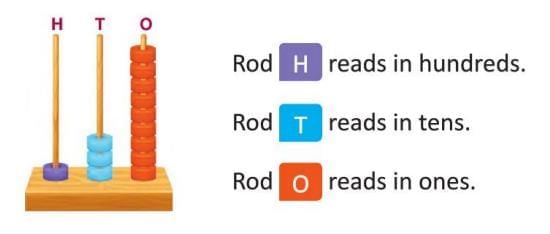
Face Value and Place Value
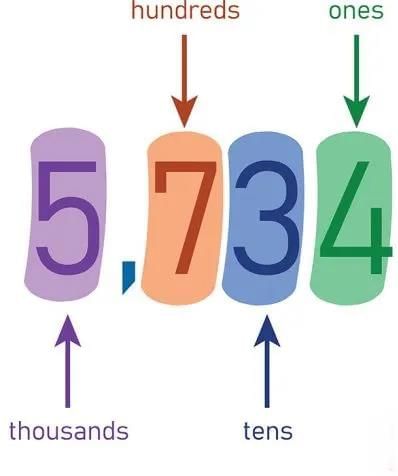
- Each digit in a number has a face value and a place value.
- Face Value: The face value is the digit itself and remains unchanged.
- Place Value: The place value depends on the digit and its position (hundreds, tens, or ones).
- Place value changes if the digit’s position changes.
- A digit has one face value but can have different place values in various numbers.
Example: In 156:
- Face value of 6 is 6; place value is 6 ones or 6.
- Face value of 5 is 5; place value is 5 tens or 50.
- Face value of 1 is 1; place value is 1 hundred or 100.
Expanded Form
- Expanded form shows a number as the sum of the place values of its digits.
- Break the number into hundreds, tens, and ones parts.
- Write each part and add them.
- For three-digit numbers, it’s written as: hundreds + tens + ones.
- Skip zero in a place unless it affects the number.
- Example: Writing 8374 in expanded form.
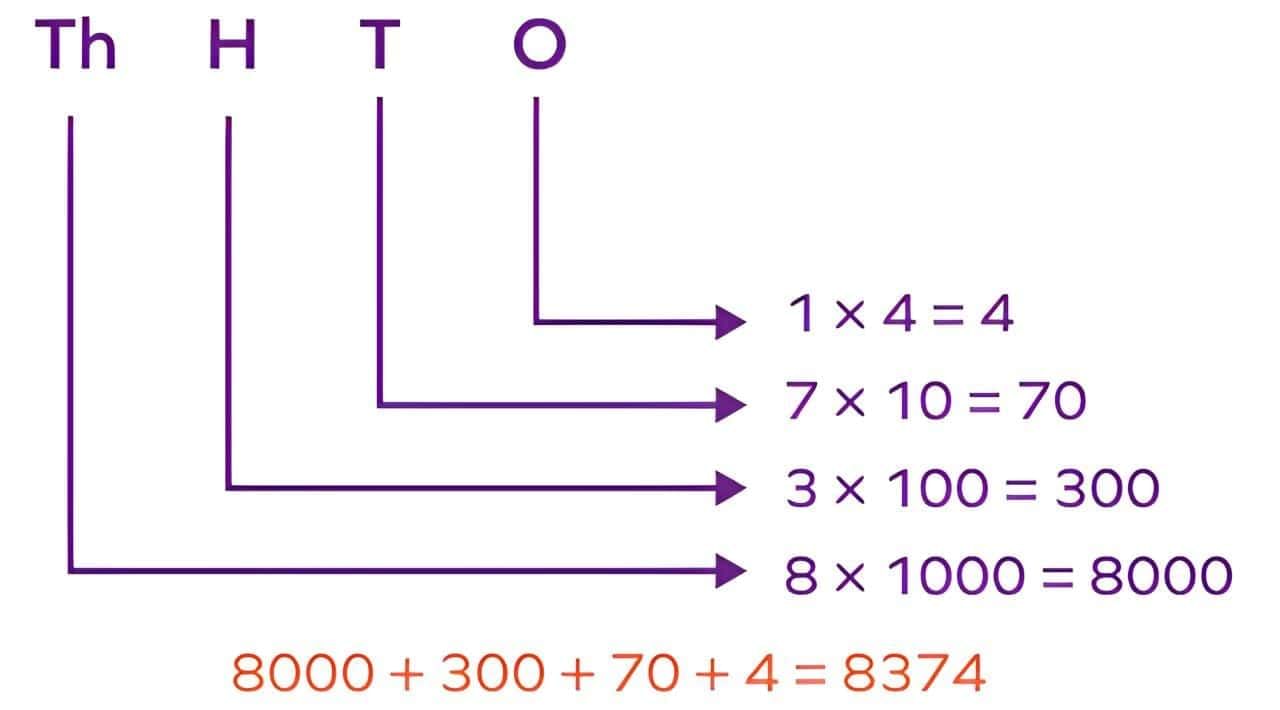
Example: The number 139 in expanded form is 100 + 30 + 9, showing 1 hundred + 3 tens + 9 ones.
Short Form
- Short form is the usual way of writing a number with digits.
- From an expanded number, place each digit in its correct position (hundreds, tens, ones).
- Use the face value of each digit in the right place value column.
- Combine the digits to form the number.
- Write 0 for a zero place value, unless it’s the leading digit.
Example: For 100 + 20 + 8:
- 1 goes in the hundreds place (1 hundred).
- 2 goes in the tens place (2 tens).
- 8 goes in the ones place (8 ones).
- The short form is 128.
Before, After and Between
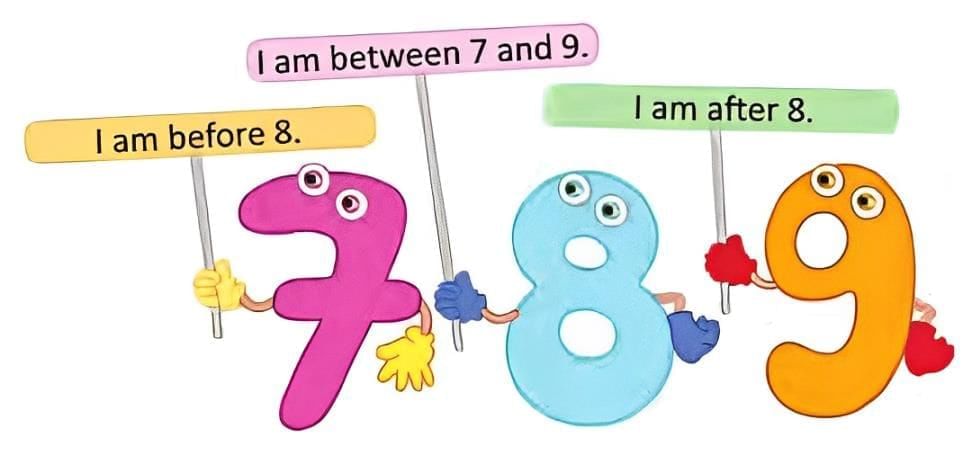
- Before: The number just before is one less, called the predecessor.
- Find the predecessor by subtracting 1.
- After: The number just after is one more, called the successor.
- Find the successor by adding 1.
- Between: The number between two numbers is in the middle.
- For consecutive numbers, the number between is one more than the smaller or one less than the larger.
Example: On a number line:


- 151 is before 152 (152 − 1 = 151).
- 159 is after 158 (158 + 1 = 159).
- 155 is between 154 and 156.
Comparing Numbers
- Compare numbers by checking the number of digits first.
- A number with more digits is always bigger.
- For same-digit numbers, compare digits from the leftmost one.
- If leftmost digits are the same, move to the next digit (e.g., tens if hundreds are equal).
- Keep comparing until a difference is found, then use <, >, or =.
Example: Compare 125 and 127:
- Both have 3 digits, so compare from the left.
- Hundreds: 1 in 125 and 1 in 127 (same).
- Tens: 2 in 125 and 2 in 127 (same).

- Ones: 5 in 125 and 7 in 127; since 5 < 7, 125 < 127.
Ordering of Numbers
- Ascending Order: Arrange from smallest to greatest.
- Descending Order: Arrange from greatest to smallest.
- Compare numbers using comparison rules to order them.
- Start with the smallest or largest number, then order the rest.
- Use < or > signs to help find the correct order.
Example:
- Ascending order: 114, 153, 192, 196 (114 < 153 < 192 < 196).
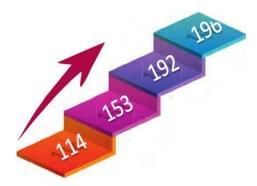
- Descending order: 187, 163, 121, 115 (187 > 163 > 121 > 115).
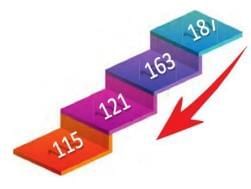
Word Problems
- Word problems involve using numbers to solve real-life situations.
- Read the problem carefully to understand what is being asked.
- Identify the numbers given and what needs to be compared or calculated.
- Use comparison skills (e.g., greater than, less than) to find the solution.
- Write a clear answer based on the comparison or calculation.
Example: Simmi counted 132 red flowers, and Aarohi counted 128 yellow flowers in a park. To find who counted more:


- Compare 132 and 128.
- Both are 3-digit numbers; hundreds are 1 (same), tens are 3 and 2 (3 > 2).
- Since 132 > 128, Simmi counted more flowers.
The document Numbers 100 to 200 Chapter Notes | General Mathematics for Primary 2 is a part of the Primary 2 Course General Mathematics for Primary 2.
All you need of Primary 2 at this link: Primary 2
|
19 videos|117 docs|38 tests
|
FAQs on Numbers 100 to 200 Chapter Notes - General Mathematics for Primary 2
| 1. What are number names and how are they used for numbers between 100 and 200? |  |
Ans. Number names are the words used to represent numbers. For example, the number 150 is written as "one hundred fifty." In the range of 100 to 200, every number has a corresponding number name, which helps in understanding and communicating quantities in a clear manner.
| 2. What is the difference between face value and place value in numbers? |  |
Ans. Face value refers to the value of a digit itself, regardless of its position in the number. For example, in the number 145, the face value of 4 is 4. Place value, on the other hand, is the value of a digit based on its position in the number. In the same example, the place value of 4 is 40 because it is in the tens place.
| 3. How do you convert a number into expanded form? |  |
Ans. Expanded form breaks down a number into the sum of its place values. For example, the number 175 can be expressed in expanded form as 100 + 70 + 5. This method helps in understanding the value of each digit within the number.
| 4. What are some strategies for comparing and ordering numbers between 100 and 200? |  |
Ans. To compare and order numbers, you can look at the hundreds, then the tens, and finally the ones. For instance, to compare 145 and 152, first compare the hundreds (both have 1), then compare the tens (4 vs. 5). Since 4 is less than 5, 145 is smaller than 152. To order a list of numbers, arrange them from the smallest to the largest using these comparisons.
| 5. How can word problems involving numbers from 100 to 200 be solved? |  |
Ans. To solve word problems, first read the problem carefully to understand what is being asked. Identify the key numbers involved and the operations needed (addition, subtraction, etc.). For example, if a problem states that there are 125 apples and 75 more apples are added, you can solve it by performing the addition: 125 + 75 = 200. This systematic approach helps in breaking down the problem for a clearer solution.
Related Searches















